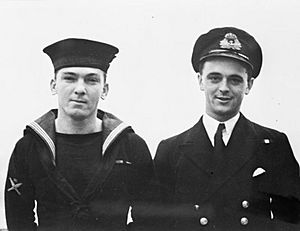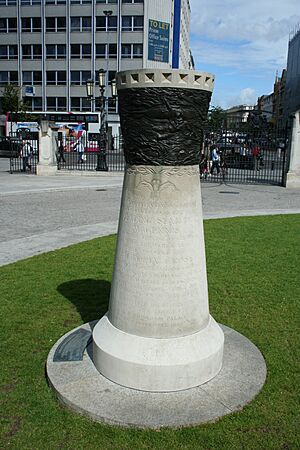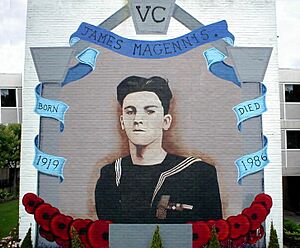James Joseph Magennis facts for kids
Quick facts for kids
James Joseph Magennis
|
|
|---|---|

Magennis (left) with Lieutenant Ian Fraser, 1945
|
|
| Birth name | James Joseph McGinnes |
| Born | 27 October 1919 Belfast, Ireland |
| Died | 12 February 1986 (aged 66) Halifax, West Yorkshire, England |
| Allegiance | United Kingdom |
| Service/ |
Royal Navy |
| Years of service | 1935–1949 |
| Rank | Leading Seaman |
| Unit | HMS Kandahar HMS XE3 |
| Battles/wars | Second World War
|
| Awards | Victoria Cross Mentioned in Despatches |
James Joseph Magennis (born October 27, 1919 – died February 12, 1986) was a brave sailor from Belfast, Ireland. He received the Victoria Cross, which is the highest award for courage given to British and Commonwealth soldiers, sailors, and airmen. He was the only person from Northern Ireland to earn this award during the Second World War.
Magennis was part of special missions using tiny submarines called X-Craft or midget submarines. These submarines attacked enemy ships. In July 1945, Magennis was serving on HMS XE3 during a mission called Operation Struggle. During an attack on a Japanese ship called Takao in Singapore, Magennis showed incredible bravery. He left the submarine twice to fix some explosive charges that were stuck. His commanding officer, Lieutenant Ian Edward Fraser, also received the Victoria Cross for his actions in this mission.
Contents
James Magennis was born on October 27, 1919, in West Belfast, Ireland. He grew up in a family there and went to St Finian's Primary School. On June 3, 1935, he joined the Royal Navy as a young sailor, called a "boy seaman."
Magennis served on several warships from 1935 to 1942. Then, he joined the submarine branch of the navy. Before joining the submarines, Magennis was on a destroyer ship called Kandahar. This ship hit a mine near Tripoli, Libya, in December 1941. Magennis was on board when it happened. The ship was badly damaged and had to be sunk the next day.
In December 1942, Magennis joined the Royal Navy Submarine Service. In March 1943, he volunteered for "special and hazardous duties." This meant working with midget submarines, also known as X-craft. He trained to be a diver for these small submarines. In September 1943, he took part in the first big mission using X-craft, called Operation Source. Two submarines, HMS X7 and HMS X6, went into Kåfjord, Norway. They managed to damage a huge German battleship called Tirpitz. For his part in this attack, Magennis was mentioned in official reports for his bravery in 1943. This award is called a Mentioned in Despatches.
Operation Struggle: A Heroic Mission
In July 1945, Magennis was an acting leading seaman. He was the diver on the midget submarine HMS XE3. The submarine was led by Lieutenant Ian Edward Fraser. Their mission was part of Operation Struggle. Their goal was to sink a 10,000-ton Japanese ship called Takao. This ship was docked in the Straits of Johor, Singapore. It was being used to defend against air attacks.
On July 30, the XE3 was pulled to the area by another submarine, Stygian. At 11:00 PM, the XE3 began its own journey. It traveled about 40 miles (64 km) through dangerous areas with shipwrecks, mines, and listening posts. The submarine reached the Takao at 1:00 PM on July 31.
Attaching the Limpet Mines
Magennis then left the submarine through a special chamber. He had to attach limpet mines to the bottom of the Takao. This was very difficult because the ship's bottom was covered in barnacles. Magennis had to scrape away the barnacles for 30 minutes before he could attach the mines.
While he was doing this, Magennis's breathing equipment was leaking oxygen. He was very tired when he returned to the submarine after finishing his task. As the submarine tried to leave, Lieutenant Fraser found that one of the mine carriers would not release itself. Magennis immediately volunteered to go back out and free it. He said he would be fine once he caught his breath. He worked for seven stressful minutes with a heavy wrench to release the carrier.
After completing this second dangerous task, Magennis returned to XE3 for the second time. The four-person midget submarine then managed to escape to the open sea. There, they met the waiting Stygian. Lieutenant Fraser also received the Victoria Cross for his part in the attack. Lieutenant William J. L. Smith, who controlled XE3 during the attack, received the Distinguished Service Order. Engineer Charles Alfred Reed, who was at the wheel, received the Conspicuous Gallantry Medal.
Another submarine, HMS XE1, was supposed to attack a different Japanese ship. However, it also ended up placing its explosives under the Takao. The commanding officer of XE1, Lieutenant John Elliott Smart, and Sub-Lieutenant Harold Edwin Harper, received the Distinguished Service Cross. Engineer Henry James Fishleigh and Leading Seaman Walter Henry Arthur Pomeroy received the Distinguished Service Medal. Other crew members were mentioned in official reports for their help in getting the submarines to the attack point.
Victoria Cross
The official announcement of Magennis's Victoria Cross was published on November 9. It described his incredible bravery:
Magennis was the diver in the midget submarine XE-3. On July 31, 1945, they attacked a Japanese cruiser. The submarine was stuck tightly under the target, so Magennis had to squeeze through a very small opening.
He had great difficulty placing his mines on the ship's bottom. The ship's hull was very dirty, and the mines would not stick easily. Magennis had to scrape away barnacles from the area before he could attach the mines. He even had to tie them together with a rope under the ship. This was very tiring work for a diver. Also, his oxygen equipment was leaking, sending bubbles to the surface. A less brave person might have just placed a few mines and returned. But Magennis kept going until he had placed all of his mines. He returned to the submarine completely exhausted.
Soon after, Lieutenant Fraser tried to release the mine carriers, but one of them would not fall off. Even though he was exhausted and his oxygen was leaking, Magennis immediately volunteered to leave the submarine again to free the carrier. He did not want a less experienced diver to do the dangerous job. After seven very tense minutes, he successfully released the carrier. Magennis showed amazing courage, dedication to his duty, and complete disregard for his own safety.
Later Life and Memorials
James Magennis was the only person from Northern Ireland to receive the Victoria Cross during the Second World War. Because of this, he became quite famous in his hometown of Belfast. The people of Belfast raised over £3,000 for him in a special fund. However, the city leaders of Belfast did not give Magennis the "freedom of the City." Some say this was due to disagreements, while others believe it was because he was from a working-class background.
In 1946, Magennis married Edna Skidmore, and they had four sons. The money from the fund was used up quickly. In 1949, he left the navy and moved back to Belfast. Later, he sold his Victoria Cross medal. In 1955, he moved to Yorkshire, England, and worked as an electrician. For the last years of his life, he was often sick. He died on February 11, 1986, from lung cancer. Just hours before he passed away, his bravery was honored by the Royal Navy with a special postage stamp.
Honoring a Hero
Magennis has several memorials in his honor. The first official recognition was just a photograph in the Belfast city council chamber. A proper memorial was finally built in 1999 after a long effort by his biographer, George Fleming. This beautiful bronze and stone statue was created by sculptor Elizabeth McLaughlin. It was unveiled in Belfast on October 8, 1999. The ceremony took place at Belfast City Hall. Magennis's son Paul and the Lord Mayor of Belfast, Bob Stoker, were there.
Ian Fraser, Magennis's former commanding officer, said: "Jim gave me bother from time to time. He liked his tot of rum, but he was a lovely man and a fine diver. I have never met a braver man. It was a privilege to know him and it's wonderful to see Belfast honour him at last." A large painting on a wall, called a mural, was made to remember James Magennis. It was unveiled on September 16, 2005, to mark 60 years since VJ Day (Victory over Japan Day).
A portrait of Magennis was painted by Belfast artist Robert Taylor Carson. This painting is now on display at the Northern Ireland War Memorial.
Magennis Plaques
In 1986, a memorial plaque was placed on an inner wall of Bradford Cathedral in England. This was done by a group of former submariners. Rear Admiral Place, who also received the Victoria Cross, unveiled the plaque. Another submariner who received the Victoria Cross in World War II, Petty Officer Tommy "Nat" Gould, was also there.
In 1998, a memorial plaque was put on the wall of Magennis's former home at 32 Carncaver Road, Castlereagh, East Belfast. Another special blue plaque was placed on the outside wall of the Royal Naval Association building in Great Victoria Street, Belfast. This plaque was sponsored by the Belfast City Council.
Images for kids





